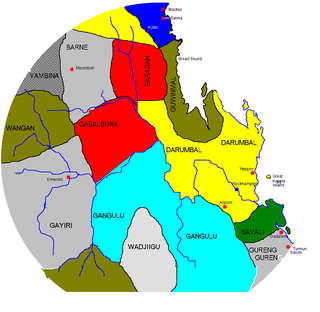Mingginda or Minkin is an extinct Australian Aboriginal language, perhaps a language isolate, of northern Australia. It was spoken by the Mingin people in the area around Burketown, on the southern coast of the Gulf of Carpentaria, in an area that contains the headwaters of the Leichhardt River.

The Shire of Burke is a local government area in North West Queensland, Australia. The shire lies on the south coast of the Gulf of Carpentaria and abuts the border with the Northern Territory. It covers an area of 39,864 square kilometres (15,391.6 sq mi), and has existed as a local government entity since 1885. The major town and administrative centre of the shire is Burketown.
The Nguburinji people, also written Ngoborindi, Oborindi and other variations, are an Aboriginal Australian people whose traditional lands lie in northwest Queensland.
The Garrwa people, also spelt Karawa and Garawa, are an Aboriginal Australian people living in the Northern Territory, whose traditional lands extended from east of the McArthur River at Borroloola to Doomadgee and the Nicholson River in Queensland.
The Tulua people were an Aboriginal Australian people of Queensland, in the southern to central region from the coast to the ranges. The Dappil and Tulua people possibly spoke the same language.
The Wakabunga are an indigenous Australian people of the state of Queensland.
The Bidjara people, also spelt Bitjara or Bithara, are an Aboriginal Australian people of south-western Queensland. They spoke a dialect of the Ngura language. They are not to be confused with the Warrego River Pitjara or the Badjiri of the Paroo River, both of whose traditional lands are further to the east of the state.
The Maikathari (Mayi-Thakurti) were an Aboriginal Australian people of the state of Queensland.
The Mayi-Kutuna, also spelt Mayaguduna and Maikudunu, are an Aboriginal Australian people of the Cape York Peninsula in the state of Queensland, whose language has become extinct.
The Maijabi (Mayi-Yapi) were an indigenous Australian people of the state of Queensland.
The Kareldi was a name assigned by Norman Tindale to Aboriginal Australian peoples of the state of Queensland. There were two groups that went by this name, the Garandi (Karandi), after the Garandi language, and the Gkuthaarn, after the Gkuthaarn language. It is not clear if they constituted a single people, but it appears that there were two dialects in the same area.
The Marrago were an Aboriginal Australian people of the state of the Cape York Peninsula in northern Queensland. They may have been a subgroup of the Mayi-Kutuna.
The Miyan, or Mian, were an indigenous people of the state of Queensland.
The Yagalingu are an Aboriginal Australian people of the state of Queensland. Their language may have been a dialect of Bidjara.

The Yambina were an Aboriginal Australian people of the state of Queensland, whose traditional lands lie inland (westwards) some distance from Mackay.
The Yukulta people, also spelt Jokula, Jukula, and other variants, and also known as Ganggalidda or Gangalidda, are an Aboriginal Australian people of the state of Queensland.
The Kunggara, also known as Kuritjara, are an indigenous Australian people of the southern Cape York Peninsula in Queensland.

The Bindal are the Aboriginal Australian people whose ancestors originally possessed, occupied, used and enjoyed approximately 2600 km2 of coastal country from the mouth of the Burdekin River north to Cape Cleveland, inland to Leichhardt Range, in the state of Queensland
The Waluwara were an indigenous Australian people of the state of Queensland.
The Iwaidja are an Indigenous Australian people of the Northern Territory.